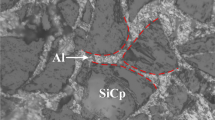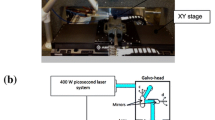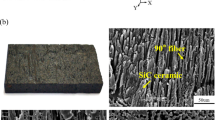Abstract
As a new ceramics matrix composite, 2.5D Cf/SiC composite has been a key material in high-temperature parts of aerospace field. However, the commonly used fiber laser drilling process tends to cause ablation damage to composite structures, which subsequently affects their fatigue lives and in-service performance. Understanding the ablation damage mechanism is crucial in controlling the fiber laser drilling process for achieving desired micro-hole quality. This paper studies the damage characteristics and correspondingly reveals the ablation mechanism in fiber laser trepan drilling of 2.5D Cf/SiC composites. It is found that there are obvious cone angles in the exit of the micro-hole at low laser scanning speed. Aiming at the special needle-punched structures of the 2.5D Cf/SiC composites, the ablation damage of the transverse fiber (0°, and 90° fiber) and needle-punched fiber bundles is analyzed by ways of scanning electron microscope (SEM) and energy dispersion spectrum (EDS) elemental analysis. Specifically, the transverse fiber is prone to needle-like, tapered, transverse fracture, longitudinal crack, and bending damage, and the needle-punched fiber bundles easily appear to interfacial debonding and extrusion fracture during the fiber laser drilling. More importantly, the results show that the layered accumulation, adherent morphology, thin shell, and bubble-like morphology are found to be four main mechanisms of recasting layers. The research provides a theoretical basis for achieving the high-quality micro-hole machining of 2.5D Cf/SiC composites with the fiber laser drilling.















Similar content being viewed by others
Data Availability
All data generated or analyzed during this paper are included in this published article.
References
Qu S, Gong Y, Yang Y, Cai M, Sun Y (2018) Surface topography and roughness of silicon carbide ceramic matrix composites. Ceram Int 44:14742–14753. https://doi.org/10.1016/j.ceramint.2018.05.104
Patel M, Saurabh K, Prasad VVB, Subrahmanyam J (2012) High temperature C/C–SiC composite by liquid silicon infiltration: a literature review. Bull Mater Sci 35:63–73. https://doi.org/10.1007/s12034-011-0247-5
Kumar S, Kumar A, Sampath K, Prasad VVB, Chaudhary JC, Gupta AK, Devi GR (2011) Fabrication and erosion studies of C–SiC composite Jet Vanes in solid rocket motor exhaust. J Eur Ceram Soc 31:2425–2431. https://doi.org/10.1016/j.jeurceramsoc.2011.06.007
Krenkel W, Berndt F (2005) C/C–SiC composites for space applications and advanced friction systems. Mater Sci Eng A 412:177–181. https://doi.org/10.1016/j.msea.2005.08.204
Ma J, Xu Y, Zhang L, Cheng L, Nie J, Dong N (2006) Microstructure characterization and tensile behavior of 2.5D C/SiC composites fabricated by chemical vapor infiltration. Scr Mater 54:1967–1971. https://doi.org/10.1016/j.scriptamat.2006.01.047
Dong WF, Xiao J, Li Y (2007) Finite element analysis of the tensile properties of 2.5D braided composites. Mater Sci Eng A 457:199–204. https://doi.org/10.1016/j.msea.2006.12.032
Spriet P, Habarou G (1997) Applications of CMCs to Turbojet engines: overview of the SEP experience. Key Eng Mater 127-131:1267–1276. https://doi.org/10.4028/www.scientific.net/KEM.127-131.1267
McNally CA, Folkes J, Pashby IR (2013) Laser drilling of cooling holes in aeroengines: state of the art and future challenges. Mater Sci Technol 20:805–813. https://doi.org/10.1179/026708304225017391
Schmidt S, Beyer S, Knabe H, Immich H, Meistring R, Gessler A (2004) Advanced ceramic matrix composite materials for current and future propulsion technology applications. Acta Astronaut 55:409–420. https://doi.org/10.1016/j.actaastro.2004.05.052
Hocheng H, Tai NH, Liu CS (2000) Assessment of ultrasonic drilling of C/SiC composite material. Compos Part Appl Sci Manuf 31:133–142. https://doi.org/10.1016/S1359-835X(99)00065-2
Yan B, Chen Z, Zhu J, Zhang J, Jiang Y (2009) Effects of ablation at different regions in three-dimensional orthogonal C/SiC composites ablated by oxyacetylene torch at 1800°C. J Mater Process Technol 209:3438–3443. https://doi.org/10.1016/j.jmatprotec.2008.08.002
Feng P, Wang J, Zhang J, Zheng J (2017) Drilling induced tearing defects in rotary ultrasonic machining of C/SiC composites. Ceram Int 43:791–799. https://doi.org/10.1016/j.ceramint.2016.10.010
Wang H, Lin H, Wang C, Zheng L, Hu X (2017) Laser drilling of structural ceramics—a review. J Eur Ceram Soc 37:1157–1173. https://doi.org/10.1016/j.jeurceramsoc.2016.10.031
Khuat V, Chen T, Dao V (2015) Fabrication of nanostructures on silicon carbide surface and microgroove sidewall using 800-nm femtosecond laser. Opt Eng 54:077102. https://doi.org/10.1117/1.OE.54.7.077102
Marimuthu S, Dunleavey J, Liu Y, Smith B, Kiely A, Antar M (2019) Characteristics of hole formation during laser drilling of SiC reinforced aluminium metal matrix composites. J Mater Process Technol 271:554–567. https://doi.org/10.1016/j.jmatprotec.2019.04.030
Wang C, Zhang L, Liu Y, Cheng G, Zhang Q, Hua K (2013) Ultra-short pulse laser deep drilling of C/SiC composites in air. Appl Phys A 111:1213–1219. https://doi.org/10.1007/s00339-012-7377-5
Liu Y, Wang C, Li W, Yang X, Zhang Q, Cheng L, Zhang L (2014) Effect of energy density on the machining character of C/SiC composites by picosecond laser. Appl Phys A 116:1221–1228. https://doi.org/10.1007/s00339-013-8213-2
Liu Y, Wang C, Li W, Wang C, Cheng L (2014) Effect of energy density and feeding speed on micro-hole drilling in C/SiC composites by picosecond laser. J Mater Process Technol 214:3131–3140. https://doi.org/10.1016/j.jmatprotec.2014.07.016
Zhang R, Li W, Liu Y, Wang CH, Wang J, Yang XJ, Cheng LF (2015) Machining parameter optimization of C/SiC composites using high power picosecond laser. Appl Surf Sci 330:321–331. https://doi.org/10.1016/j.apsusc.2015.01.010
Zhai Z, Wang W, Mei X, Li M, Cui J, Wang F, Pan A (2018) Effect of the surface microstructure ablated by femtosecond laser on the bonding strength of EBCs for SiC/SiC composites. Opt Commun 424:137–144. https://doi.org/10.1016/j.optcom.2018.04.055
Tong Y, Bai S, Zhang H, Ye Y (2013) Laser ablation behavior and mechanism of C/SiC composite. Ceram Int 39:6813–6820. https://doi.org/10.1016/j.ceramint.2013.02.012
Wu ML, Ren CZ, Xu HZ (2016) Comparative study of micro topography on laser ablated C/SiC surfaces with typical uni-directional fibre ending orientations. Ceram Int 42:7929–7942. https://doi.org/10.1016/j.ceramint.2016.01.173
Pan SN, Li QY, Xian ZK, Su NG, Zeng FZ (2019) The effects of laser parameters and the ablation mechanism in laser ablation of C/SiC composite. Materials 12:3076. https://doi.org/10.3390/ma12193076
Saini SK, Dubey AK (2019) Study of material characteristics in laser trepan drilling of ZTA. J Manuf Process. 44:349–358. https://doi.org/10.1016/j.jmapro.2019.06.017
Zhai Z, Wang W, Zhao J, Mei X, Wang K, Wang F, Yang H (2017) Influence of surface morphology on processing of C/SiC composites via femtosecond laser. Compos Part Appl Sci Manuf 102:117–125. https://doi.org/10.1016/j.compositesa.2017.07.031
Canmus G (1996) Development of damage in a 2D woven C/SiC composite under mechanical loading: I. Mechanical characterization. Compos Sci Technol 56:1363–1372. https://doi.org/10.1016/S0266-3538(96)00094-2
Bobet JL, Lamon J (1995) Thermal residual stresses in ceramic matrix composites—I. Axisymmetrical model and finite element analysis. Acta Metall Mater 43:2241–2253. https://doi.org/10.1016/0956-7151(94)00429-3
Wang J, Ma Y, Liu Y, Yuan W, Song H, Huang C, Yin X (2019) Experimental investigation on laser ablation of C/SiC composites subjected to supersonic airflow. Opt Laser Technol 113:399–406. https://doi.org/10.1016/j.optlastec.2019.01.019
Herrmann M, Schönfeld K, Klemm H, Lippmann W, Hurtado A, Michaelis A (2014) Laser-supported joining of SiC-fiber/SiCN ceramic matrix composites fabricated by precursor infiltration. J Eur Ceram Soc 34:2913–2924. https://doi.org/10.1016/j.jeurceramsoc.2014.03.016
Nasiri NA, Patra N, Ni N, Jayaseelan DD, Lee WE (2016) Oxidation behaviour of SiC/SiC ceramic matrix composites in air. J Eur Ceram Soc 36:3293–3302. https://doi.org/10.1016/j.jeurceramsoc.2016.05.051
Code availability
Not applicable
Funding
This work is supported by the Natural Science Foundation of Tianjin (No. 18JCQNJC75600), and the Tianjin Research Innovation Project for Postgraduate Students (No. 2020YJSS053).
Author information
Authors and Affiliations
Contributions
Chang Liu: investigation; methodology; validation; writing—original draft; writing—review and editing; Xianze Zhang: methodology; validation; writing—original draft; writing—review and editing; Lei Gao: software, data curation; Xiaogeng Jiang: supervision, writing—review and editing; Xiaodong Wang: experiments; Tao Yang: supervision
Corresponding author
Ethics declarations
Ethical approval
Not applicable
Consent to participate
Not applicable
Consent to publish
Not applicable
Competing interests
The authors declare no competing interests.
Additional information
Publisher’s note
Springer Nature remains neutral with regard to jurisdictional claims in published maps and institutional affiliations.
Statement: The submitted paper is original and has not been published before. It is not under consideration for publication anywhere else. Its publication has been approved by all co-authors.
Rights and permissions
About this article
Cite this article
Liu, C., Zhang, X., Gao, L. et al. Study on damage characteristics and ablation mechanism in fiber laser trepan drilling of 2.5D Cf/SiC composites. Int J Adv Manuf Technol 117, 3647–3660 (2021). https://doi.org/10.1007/s00170-021-07896-5
Received:
Accepted:
Published:
Issue Date:
DOI: https://doi.org/10.1007/s00170-021-07896-5




